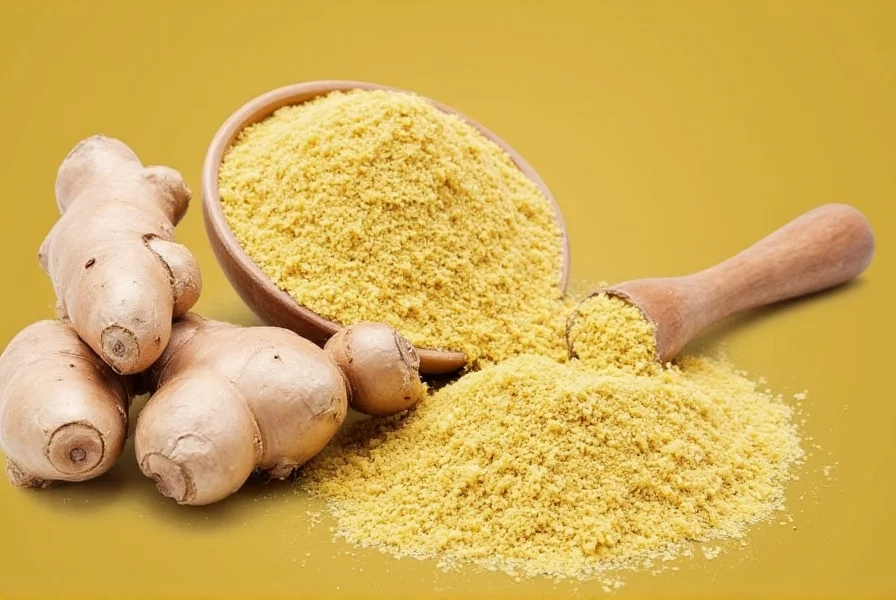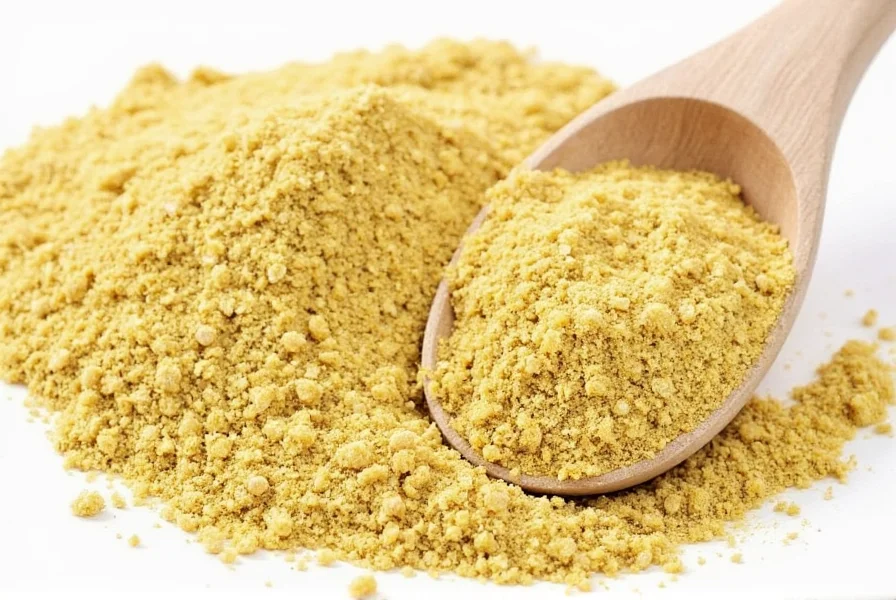Running out of ground ginger while cooking doesn't have to ruin your recipe. Understanding proper ginger substitutes ensures your dishes maintain the warm, spicy-sweet flavor profile that makes ginger so valuable in both sweet and savory applications. Whether you're baking cookies, preparing Asian cuisine, or crafting homemade chai, knowing these alternatives keeps your culinary projects on track.
Understanding Ground Ginger's Unique Flavor Profile
Ground ginger offers a concentrated, warm, slightly sweet, and peppery flavor that's distinct from fresh ginger. It's commonly used in baking, spice blends, and recipes where fresh ginger's moisture content would alter the dish's texture. When seeking a ground ginger replacement, consider these key characteristics:
- Warm, spicy-sweet flavor with citrus notes
- Drier texture than fresh ginger
- More concentrated flavor than fresh (about 1:4 ratio)
- Essential in certain spice blends like garam masala
Top 7 Ground Ginger Substitutes Ranked by Effectiveness

1. Fresh Ginger Root (Best Overall Substitute)
When you need a ground ginger replacement, fresh ginger is your most versatile option. It provides the authentic ginger flavor with more pronounced citrus notes and a sharper bite.
Conversion ratio: 1/4 teaspoon ground ginger = 1 tablespoon freshly grated ginger
Best for: Stir-fries, marinades, sauces, and recipes where liquid content won't affect texture. For baking, squeeze out excess moisture from grated ginger using a paper towel.
2. Galangal Powder (Best for Southeast Asian Dishes)
Galangal shares ginger's peppery quality but with more earthy, pine-like notes. Powdered galangal makes an excellent ground ginger substitute in Thai and Indonesian recipes.
Conversion ratio: Use equal parts galangal powder for ground ginger
Best for: Tom yum soup, Thai curries, and other Southeast Asian dishes where authentic flavor matters more than perfect replication.
3. Allspice (Best Baking Alternative)
Allspice combines flavors of cinnamon, nutmeg, and cloves, making it surprisingly effective as a ground ginger replacement in baked goods.
Conversion ratio: Use 3/4 teaspoon allspice for every 1 teaspoon ground ginger required
Best for: Gingerbread, spice cakes, pumpkin pies, and other baked goods where ginger's warmth matters more than its specific flavor.
4. Cinnamon-Cardamom Blend (Best for Sweet Applications)
This combination mimics ginger's warmth while adding complementary baking spices.
Conversion ratio: For each teaspoon of ground ginger, use 1/2 teaspoon cinnamon + 1/4 teaspoon cardamom
Best for: Cookies, cakes, oatmeal, and chai tea where ginger's specific flavor isn't critical to the dish's identity.
5. Mace (Best for Savory Dishes)
Mace offers a more delicate, slightly citrusy warmth that works well in place of ginger in certain savory applications.
Conversion ratio: Use 1/2 teaspoon mace for every 1 teaspoon ground ginger
Best for: Meat rubs, roasted vegetables, and creamy sauces where you want warmth without ginger's distinctive bite.
6. Ginger Extract or Crystallized Ginger
Ginger extract provides concentrated flavor without texture issues, while crystallized ginger can be finely minced.
Conversion ratio: 1/8 teaspoon ginger extract = 1/4 teaspoon ground ginger; 2 tablespoons finely minced crystallized ginger = 1 teaspoon ground ginger
Best for: When precise flavor control matters more than texture considerations.
7. Five-Spice Powder (Best for Asian-Inspired Dishes)
This Chinese spice blend contains star anise, fennel, cloves, Szechuan pepper, and cinnamon, creating a complex flavor that can stand in for ginger.
Conversion ratio: Use 3/4 teaspoon five-spice powder for every 1 teaspoon ground ginger
Best for: Stir-fries, marinades, and Asian-inspired dishes where ginger's specific flavor isn't essential.
| Substitute | Conversion Ratio | Best Recipe Applications | Flavor Difference |
|---|---|---|---|
| Fresh Ginger | 1 tbsp fresh = 1/4 tsp ground | Stir-fries, sauces, marinades | More citrusy, sharper bite |
| Galangal Powder | 1:1 replacement | Thai/Indonesian dishes | More earthy, pine-like notes |
| Allspice | 3/4 tsp = 1 tsp ginger | Baking, spice cakes | Warmer, less citrusy |
| Cinnamon-Cardamom | 1/2 tsp cinnamon + 1/4 tsp cardamom = 1 tsp ginger | Cookies, chai, oatmeal | Sweeter, less spicy |
| Mace | 1/2 tsp = 1 tsp ginger | Savory dishes, meat rubs | More delicate, floral notes |
When Substituting Ground Ginger: Key Considerations
Not all ginger replacements work equally well in every situation. Consider these factors when choosing your ground ginger alternative:
Recipe Type Matters Most
The best substitute for ground ginger in baking differs from what works in savory dishes. For gingerbread cookies, allspice or the cinnamon-cardamom blend preserves the warm spice profile. In stir-fries, fresh ginger or galangal maintains the authentic Asian flavor profile.
Moisture Content Adjustments
When using fresh ginger as a ground ginger replacement, remember it contains about 80% water. For baking recipes, squeeze excess moisture from grated ginger using cheesecloth or paper towels to prevent altering your recipe's liquid balance.
Flavor Intensity Variations
Ginger's pungency varies by substitute. Allspice and mace provide warmth without ginger's distinctive bite, while galangal offers a different but complementary flavor. Start with slightly less than the recommended ratio, then adjust to taste.
Avoid These Common Substitution Mistakes
- Using ground turmeric as a 1:1 replacement (too earthy, different flavor profile)
- Substituting with ginger ale or ginger beer (wrong flavor concentration)
- Using crystallized ginger without adjusting sugar content in recipes
- Replacing ground ginger with fresh in recipes where texture matters (like dry spice rubs)
When Not to Substitute Ground Ginger
Some recipes rely specifically on ground ginger's unique properties. These include:
- Traditional ginger snaps (ground ginger provides the characteristic snap)
- Certain Indian spice blends like garam masala
- Recipes specifically designed around ground ginger's concentrated flavor
In these cases, it's better to make a quick trip to the store rather than compromise the dish's integrity.
Practical Tips for Successful Substitution
Follow these professional kitchen tips when replacing ground ginger:
- Taste as you go: Add substitute incrementally, especially with potent options like allspice
- Consider complementary spices: When using allspice or mace, add a pinch of black pepper to mimic ginger's bite
- Adjust cooking time: Fresh ginger benefits from longer cooking to mellow its sharpness
- Store properly: Keep unused substitutes in airtight containers away from light and heat
Frequently Asked Questions
Can I use ground turmeric as a substitute for ground ginger?
While turmeric comes from the same plant family, it's not an ideal ground ginger replacement. Turmeric has an earthier, more bitter flavor with less warmth and no citrus notes. In small amounts (1/4 teaspoon turmeric for 1 teaspoon ginger), it can add color and some warmth, but the flavor profile differs significantly. For most recipes, allspice or a cinnamon-cardamom blend works better as a ground ginger alternative.
What's the best ground ginger substitute for baking cookies?
For baking cookies, allspice is the most effective ground ginger replacement. Use 3/4 teaspoon allspice for every 1 teaspoon of ground ginger called for in your recipe. The warm, slightly sweet profile of allspice mimics ginger's contribution to cookie recipes without overwhelming other flavors. For ginger snap cookies specifically, consider adding 1/8 teaspoon black pepper to the allspice to replicate ginger's characteristic bite.
How do I substitute fresh ginger for ground ginger in a recipe?
The proper conversion ratio is 1/4 teaspoon ground ginger = 1 tablespoon freshly grated ginger. When substituting fresh for ground ginger, remember that fresh ginger contains moisture that could affect your recipe's texture. For baking applications, squeeze excess liquid from grated ginger using cheesecloth or paper towels. In savory dishes like stir-fries, add fresh ginger earlier in the cooking process to allow its sharper flavor to mellow.
Can I use ground cinnamon instead of ground ginger?
Ground cinnamon alone isn't an ideal replacement for ground ginger, as it lacks ginger's distinctive warmth and bite. However, a blend of 1/2 teaspoon cinnamon plus 1/4 teaspoon cardamom makes an excellent ground ginger substitute in sweet applications like cookies, cakes, and chai tea. This combination captures ginger's warmth while adding complementary baking spices. For savory dishes, consider adding a pinch of black pepper to the cinnamon-cardamom blend to better mimic ginger's peppery quality.
What's the difference between using fresh ginger versus ground ginger in recipes?
Fresh ginger has a brighter, more citrusy flavor with a sharper bite, while ground ginger offers a warmer, more concentrated, and slightly sweeter profile. Ground ginger works better in dry applications like spice rubs or baking where moisture content matters. Fresh ginger shines in sauces, marinades, and stir-fries where its moisture contributes to the dish. The conversion ratio is approximately 1 tablespoon fresh grated ginger = 1/4 teaspoon ground ginger. When substituting, consider how moisture content might affect your final dish.











 浙公网安备
33010002000092号
浙公网安备
33010002000092号 浙B2-20120091-4
浙B2-20120091-4